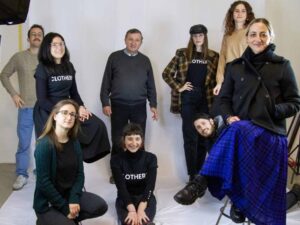
Workshop
Clothest, non-profit e-commerce

The Clothest team from Florence, Italy is regenerating used high fashion clothing and helping to fight the culture of waste: “We know that waste, the “stone that was rejected,” has become the cornerstone. Therefore, through our work, we try to rediscover the beauty in what has been discarded and assign a new value to it.
Letizia Baldetti works in the fashion world and is also one of the young volunteers of the Giglio di Montevarchi Family Home in Arezzo, Italy, which hosts forty permanent and temporary residents. In the parish of Santa Maria del Giglio, very close to the railway station, and led by Fr Mauro Frasi, there is also a Caritas Center, as well as a food and clothing distribution center, which draws 200 people every year. “Most of the guests arrive alone, 90% of them from the railway station. We say that our family is a home “between the train station and the church,” Letizia jokes. Among the permanent guests there are people with psychiatric problems, while many of the temporary guests unemployed. There are foreigners but also Italians: “On the average the Italians are over the age of 50, men who ended up in poverty after a marriage separation or because they lost their jobs because of the crisis. Some arrive alone, after sleeping many nights outdoors, or because they have been referred to us”.

The family home is also the weekly meeting place for the committed young people of the parish. It was there that five years ago the idea of Clothest was born: “One Sunday evening we were in the family home for dinner and doing other activities, and as we distributed the used clothing we began to notice that we were receiving brand name clothing. Which, of course, was not so significant for a poor person who was more interested in having a nice cold-resistant down coat. Then we asked ourselves if there might be a way to make better use of them for the poor. Then came Francesco’s idea of The S-Speranza, a volunteer association inspired by the words and thoughts of Pope Francis on the culture of waste: “We operate from a family home and are well aware that the people who come to us are the ‘discarded’ by society, like the clothes we receive that have been discarded from people’s wardrobes. Yet, the stone that was discarded has become the cornerstone. Therefore, through our work, we try to rediscover the beauty in what had been discarded, to give it a new value.” In a short time, the group collected about 2,400 used garments which were resold in temporary shops and on eBay.
As of today 17 young people are involved in the project and they come from several areas of Tuscany: Prato, Pisa, Le Sieci, Pontassieve, Levane and Cavriglia. Some of them take care of photographing the garments, others recover them, others create and manage software for the warehouse, and others create the new looks. They have combined their talents and created Clothest, a non-profit E-commerce that collects and sells used clothing of high fashion brands to finance the Montevarchi Family Home projects of assistance. Their website also provides space for telling the stories of the regenerated clothing because, as they say,”There is no such thng as waste, since everything has a history and a value just as every human being has a name, a history and individual dignity.”
Letizia recalls: “The story that touched me the most is that of Enza’s dress… We were at her and her husband’s house with the group of young people from the parish, for training and to hear their story. We talked to them about Clothest. Without thinking twice, Enza gets up, goes up to the bedroom, takes a dress from the closet, brings it to us and says: “This is the dress in which I accompanied my son to the altar. I kept it because it reminds me of one of the best and most important days of my life, but now I’ve really found a better place for it!” We obviously got excited!
There is also the story of a wedding dress, which reads: “I’m a volunteer of Caritas. I was a widower. One of the hardest things when you lose the person you loved is to detach yourself from her things. But then you realize that keeping them there won’t make her come back … So, you start thinking about what to do with them, how to honor what holds the memory of her. When I found this, the dress she wore when we got married, it was difficult, a blow to the heart. And with this, what am I to do? Then, Father Mauro arrived for a meeting and teld us about Clothest. I went home, got it, took it to him. . . Let this dress live on and continue to bring the memory of our love to the world.”
Currently, the Clothest project has been given a home at the Lionello Bonfanti Center, Loppiano, Italy, which is a reference point for companies that belong to the Civil Economy and Communion Project in Italy. “Being at the Center allows us to be a real warehouse, because the garments we have collected in these 5 years are so many! At the moment, we have 200 items for sale. At the Center we can have have the photo studio at the same location as the warehouse. The future dream would be to find a space that could also accommodate the laundry and tailoring, where small adjustments are made. This is where we would envision the first job opportunities for disadvantaged people.” Because the next goal, the next dream of Clothest would be to include on its staff the people welcomed at the Family Home, who are the recipients of what is collected by E-commerce.
Letizia concludes: “We think that it’s not necessary to make some kind of revolution to change the world. . . but the revolution can start from little things, like simply looking into your closet and choosing to donate a garment rather than throwing it away and generating waste. Or, by choosing to buy a used garment instead of a new one, saving the planet a lot of energy”.






